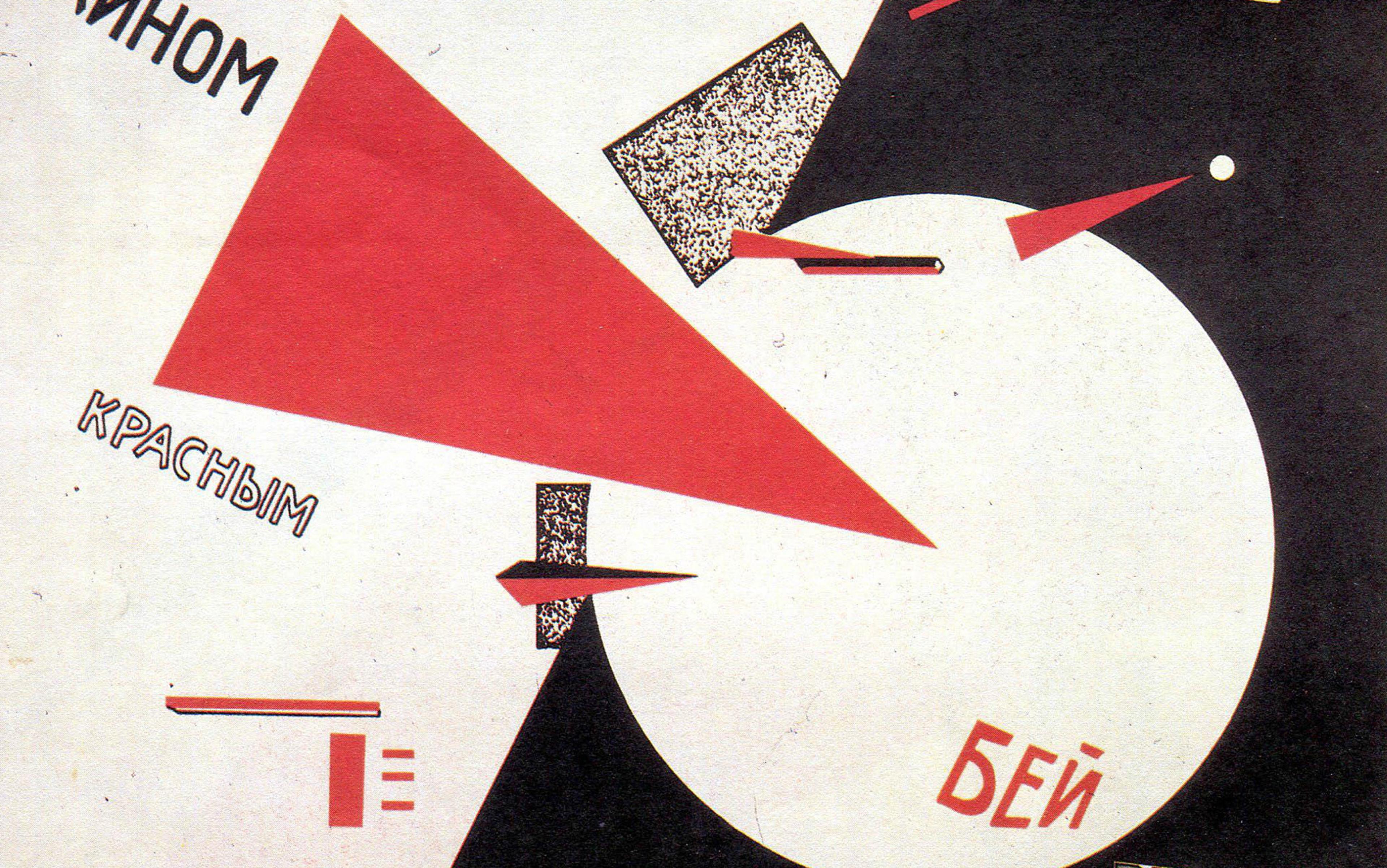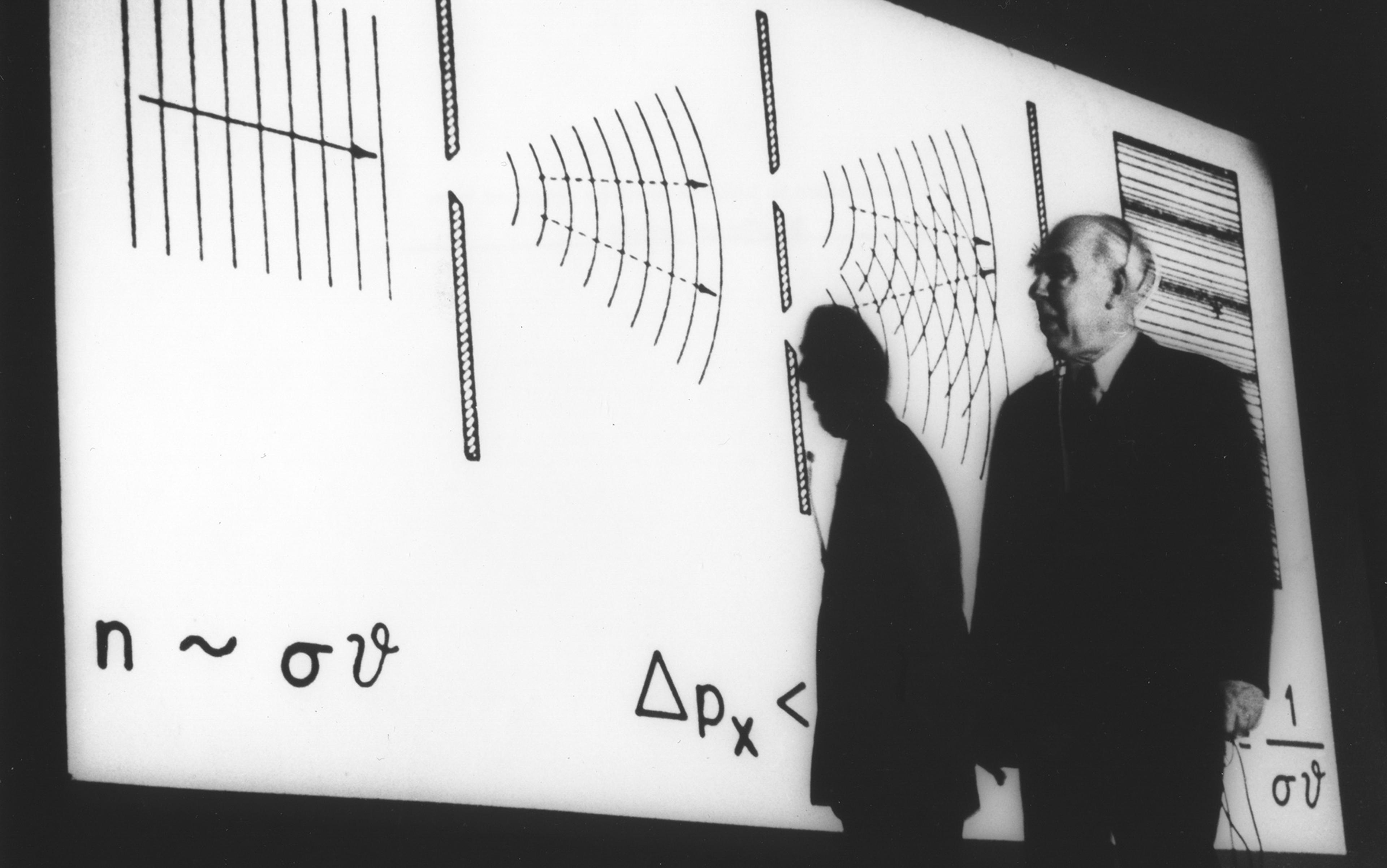The quantum revolution in physics played out over a period of 22 years, from 1905 to 1927. When it was done, the new theory of quantum mechanics had completely undermined the basis for our understanding of the material world. The familiar and intuitively appealing description of an atom as a tiny solar system, with electrons orbiting the atomic nucleus, was no longer satisfactory. The electron had instead become a phantom. Physicists discovered that in one kind of experiment, electrons behave like regular particles – as small, concentrated bits of matter. In another kind of experiment, electrons behave like waves. No experiment can be devised to show both types of behaviour at the same time. Quantum mechanics is unable to tell us what an electron is.
More unpalatable consequences ensued. The uncertainty principle placed fundamental limits on what we can hope to discover about the properties of quantum ‘wave-particles’. Quantum mechanics also broke the sacred link between cause and effect, wreaking havoc on determinism, reducing scientific prediction to a matter of probability – to a roll of the dice. We could no longer say: when we do this, that will definitely happen. We could say only: when we do this, that will happen with a certain probability.
As the founders of the theory argued about what it meant, the views of the Danish physicist Niels Bohr began to dominate. He concluded that we have no choice but to describe our experiments and their results using seemingly contradictory, but nevertheless complementary, concepts of waves and particles borrowed from classical (pre-quantum) physics. This is Bohr’s principle of ‘complementarity’. He argued that there is no contradiction because, in the context of the quantum world, our use of these concepts is purely symbolic. We reach for whichever description – waves or particles – best serves the situation at hand, and we should not take the theory too literally. It has no meaning beyond its ability to connect our experiences of the quantum world as they are projected to us by the classical instruments we use to study it.
Bohr emphasised that complementarity did not deny the existence of an objective quantum reality lying beneath the phenomena. But it did deny that we can discover anything meaningful about this. Alas, despite his strenuous efforts to exercise care in his use of language, Bohr could be notoriously vague and more than occasionally incomprehensible. Pronouncements were delivered in tortured ‘Bohrish’. It is said of his last recorded lecture that it took a team of linguists a week to discover the language he was speaking. And physicists of Bohr’s school, most notably the German theorist Werner Heisenberg, were guilty of using language that, though less tortured, was frequently less cautious.
It was all too easy to interpret some of Heisenberg’s pronouncements as a return to radical subjectivism, to the notion that our knowledge of the world is conjured only in the mind without reference to a real external world. It did not help that Bohr and physicists of Bohr’s school sought to shoehorn complementarity into other domains of enquiry, such as biology and psychology, and attempted to use it to resolve age-old conundrums concerning free will and the nature of life. Such efforts garnered little support from the wider scientific community and attracted plenty of opprobrium.
Albert Einstein famously pushed back, declaring that, unlike quantum mechanics, God does not play dice. He argued that, while quantum mechanics was undoubtedly powerful, it was in some measure incomplete.
In 1927, Bohr and Einstein commenced a lively debate. Einstein was joined in dissent by the Austrian physicist Erwin Schrödinger, who devised the conundrum of ‘Schrödinger’s cat’ to highlight the seemingly absurd implications of quantum mechanics. But although both Einstein and Schrödinger remained strident critics, they offered no counter-interpretation of their own. Despite their misgivings, there was simply no consensus on a viable alternative to complementarity.
Complementarity also fell foul of the principal political ideologies that, in different ways, dominated human affairs from the early 1930s, through the Second World War, to the Cold War that followed. Both Bohr and Einstein were of Jewish descent and, to Nazi ideologues, complementarity and relativity theory were poisonous Jewish abstractions, at odds with the nationalistic programme of Deutsche Physik, or ‘Aryan physics’. But the proponents of Deutsche Physik failed to secure the backing of the Nazi leadership, and any threat to complementarity from Nazi ideology disappeared with the war’s ending. Much more enduring were the objections of Soviet communist philosophers who argued that complementarity was at odds with the official Marxist doctrine of ‘dialectical materialism’.
Vladimir Lenin, who had led the Bolshevik Party in the October Revolution of 1917, was a dogmatic advocate of the materialist worldview expounded by the German philosophers Karl Marx and Friedrich Engels, authors of The Communist Manifesto, first published in 1848. The world according to Marxism consists of objectively existing matter in constant motion, bound by laws. Such laws govern different levels of existence that we attempt to describe through different scientific disciplines that are not necessarily reducible one to another. For example, sociology – regarded as an empirical science – is not reducible to physics and is therefore bound by its own laws of human social and economic behaviour.
Marx and Engels observed that such behaviour breeds functional contradictions within an organised society. To survive, people submit to exploitative relationships with the means of economic production and those who own them. Distinct classes emerge: masters and their slaves, lords and their serfs, business owners (the bourgeoisie) and their low-wage workers (the proletariat).
It was not enough just to interpret the world, Marx claimed. Philosophers must also seek to change it
These functional contradictions are ultimately resolved through inevitable class struggle resulting in irreversible changes in social organisation and the means of production. The classical antiquity of Greece and Rome had given way to feudalism. Feudalism had given way to capitalism. And capitalism was destined to give way to socialism and communism, to the utopia of a classless society. But the necessary changes in social organisation would not happen by themselves. The path led first through socialism and the ‘dictatorship of the proletariat’, supported by an autocratic state that would eventually no longer be needed when the communist utopia was realised. For Lenin, the ends justified the means, which included the violent repression of bourgeois capitalist and counter-revolutionary forces.
In Marxist philosophy, the method of studying and apprehending both social and physical phenomena is dialectical, and the interpretation of natural phenomena is firmly materialistic. It was not enough just to interpret the world, Marx claimed. Philosophers must also seek to change it, and this could not be done in a world built only from perceptions and ideas. Any philosophy that sought to disconnect us from material reality, by reducing the world to mere sensation and experience, posed a threat to Marxism.
In Materialism and Empirio-Criticism (1909), Lenin had berated the physicist Ernst Mach and his Russian followers, and the German philosopher Richard Avenarius, who had formulated the positivist doctrine of empirio-criticism. The philosophy of positivism was anathema, as it sought to reduce knowledge of the world to sensory experience. Lenin argued that such thinking led only to a subjective idealism, or even solipsism. To him, this was just so much ‘gibberish’.
Complementarity looked just like the kind of positivist gibberish that Lenin had sought to annihilate. A reality accessible only in the form of quantum probabilities did not suit the needs of the official philosophy of Soviet communists. It appeared to undermine orthodox materialism. Nevertheless, an influential group of Soviet physicists, including Vladimir Fock, Lev Landau, Igor Tamm and Matvei Bronstein, promoted Bohr’s views and for a time represented the ‘Russian branch’ of Bohr’s school. This was not without some risk. Communist Party philosophers sought their dismissal, to no avail, largely because they could not agree on the issues among themselves.
The situation in the Soviet Union changed dramatically a few years later. As his health declined, Lenin had tried to remove the Communist Party’s general secretary, Joseph Stalin, whom he deemed unfit for the role. But Stalin had been quietly consolidating his position and had placed loyalists in key administrative posts. After a brief power struggle following Lenin’s death in 1924, Stalin became supreme leader. In 1937-38, he tightened his grip by unleashing a reign of terror, known as the Great Purge, in which many of the old Bolsheviks who had fought alongside Lenin in 1917 were executed. Although the total death toll is difficult to determine, a figure of 1 million is not unreasonable. Physicists were not exempt. Bronstein was arrested, accused of terrorism offences, and executed in February 1938.
Stalin put his own stamp on the political ideology of Soviet communists in his short text titled Dialectical and Historical Materialism (1938), a formulation of Marxist philosophy that would be adopted as the official Communist Party line. Those intellectuals who resisted the official doctrine now faced real risks of losing more than just their jobs.
An outspoken commitment to complementarity became positively dangerous
The distractions of the Second World War meant that little changed for physicists until Andrei Zhdanov, the Party’s philosopher and propagandist-in-chief, who was thought by many to be Stalin’s successor-in-waiting, specifically targeted the interpretation of quantum mechanics in a speech delivered in June 1947. ‘The Kantian vagaries of modern bourgeois atomic physicists,’ he proclaimed, ‘lead them to inferences about the electron’s possessing “free will”, to attempts to describe matter as only a certain conjunction of waves, and to other devilish tricks.’ This was the beginning, writes the historian Loren Graham, ‘of the most intense ideological campaign in the history of Soviet scholarship’. An outspoken commitment to complementarity became positively dangerous.
Soviet physicists scrambled to defensible positions. Fock retreated from complementarity as an objective law of nature, and criticised Bohr for his vagueness. Others sought ways to ‘materialise’ quantum mechanics. Dmitry Blokhintsev, a student of Tamm’s, favoured a statistical interpretation based on the collective properties of an ‘ensemble’ of real particles. In such an interpretation we are obliged to deal with probabilities simply because we are ignorant of the properties and behaviours of the individual material particles that make up the ensemble. Einstein had used this conception in the opening salvo of his debate with Bohr in 1927. Yakov Terletsky who, like Tamm, had studied under the Soviet physicist Leonid Mandelstam, favoured a ‘pilot-wave’ interpretation of the kind that had initially been promoted by the French physicist Louis de Broglie before it was shot down by Bohr’s school in 1927. In this interpretation, a real wave field guides real particles, and probabilities again arise because we are ignorant of the details.
As the 1930s progressed towards world war, many Western intellectuals had embraced communism as the only perceived alternative to the looming threat of Nazism. Numbered among the small group of Jewish communist physicists gathered around J Robert Oppenheimer at the University of California, Berkeley was David Bohm. As Oppenheimer began to recruit a team of theorists to work on the physics of the atomic bomb at the newly established Los Alamos National Laboratory in early 1943, Bohm was high on his list. But Bohm’s communist affiliations led the director of the Manhattan Project, Leslie Groves, to deny him the security clearance necessary to join the project.
Bohm was left behind at Berkeley and joined with his fellow communist and close friend Joseph Weinberg in teaching the absent Oppenheimer’s course on quantum mechanics. His long discussions with Weinberg, who argued that complementarity was itself a form of dialectic and so not in conflict with Marxist philosophy, encouraged him to accept Bohr’s arguments, although he was not free of doubt. In his textbook Quantum Theory (1951), derived in part from his experiences teaching Oppenheimer’s course, Bohm broadly adhered to Bohr’s views.
Bohm had by this time moved to Princeton University in New Jersey. Einstein, who in 1933 had fled from Nazi Germany to Princeton’s Institute for Advanced Study, asked to meet with him sometime in the spring of 1951. The meeting re-awakened the Marxist materialist in Bohm. As Einstein explained the basis for his own misgivings, Bohm’s doubts returned. ‘This encounter with Einstein had a strong effect on the direction of my research,’ he later wrote, ‘because I then became seriously interested in whether a deterministic extension of the quantum theory could be found.’ Was there, after all, a more materialistic alternative to complementarity? ‘My discussions with Einstein … encouraged me to look again.’ Although there is no documented evidence to support it, Bohm later claimed he had also been influenced ‘probably by Blokhintsev or some other Russian theorist like Terletsky’.
Bohm’s theory sought to restore causality and determinism to the quantum world
But Bohm’s relationship with Weinberg had by now returned to haunt him. In March 1943, Weinberg had been caught betraying atomic secrets by an illegal FBI bug planted in the home of Steve Nelson, a key figure in the Communist Party apparatus in the San Francisco Bay Area. This evidence was inadmissible in court. In an attempt to expose Weinberg’s betrayal, in May 1949 Bohm had been called to testify to the House Un-American Activities Committee, set up by the House of Representatives to investigate communist subversion in the US. He pleaded the Fifth Amendment, a standard means of avoiding self-incrimination, which only raised more suspicion.
Bohm was arrested, then brought to trial in May 1951. He was acquitted (as was Weinberg a couple of years later). Now caught in the anti-communist hysteria whipped up by Joseph McCarthy, Bohm lost his position at Princeton. Only Einstein tried to help, offering to bring him to the Institute. But its new director – Oppenheimer, now lauded as the ‘father of the atomic bomb’ and increasingly haunted by the FBI’s interest in his own Leftist past – vetoed Bohm’s appointment. Bohm left the US for exile in Brazil, from where he published two papers setting out what was, in effect, a re-discovery of de Broglie’s pilot-wave theory. The theory sought to restore causality and determinism to the quantum world and was firmly materialist. Oppenheimer rejected Bohm’s efforts as ‘juvenile deviationism’. Einstein, who had once toyed with a similar approach and might have been expected to be sympathetic, declared it ‘too cheap’.
Under a barrage of criticism, Bohm gained support from the French physicist Jean-Pierre Vigier, then assistant to de Broglie in Paris. He was just what Bohm needed: a resourceful theorist, a man of action, a hero of the French Resistance during the war, and a friend of the president of the Democratic Republic of Vietnam, Ho Chi Minh. Invited to join Einstein in Princeton, Vigier’s communist associations had led the Department of State to forbid his entry into the US. He worked with Bohm on another variation of the pilot-wave theory and persuaded de Broglie to rekindle his interest in it, sounding alarm bells among the Bohr faithful: ‘Catholics and communists in France are uniting against complementarity!’
But Bohm’s mission to restore materiality to quantum mechanics amounted to more than demonstrating the possibility of a deterministic alternative. In 1935, working with his Princeton colleagues Boris Podolsky and Nathan Rosen, Einstein had set up a stubborn challenge, a last throw of the dice in his debate with Bohr. In the Einstein-Podolsky-Rosen (EPR) thought experiment, a pair of quantum particles interact and move apart, to the left and right, their properties correlated by some physical law. Schrödinger invented the term ‘entanglement’ to describe their situation. For simplicity, we assume that the particles can have properties ‘up’ and ‘down’, each with a 50 per cent probability.
We have no way of knowing in advance what results we’re going to get for each particle. But if the particle on the left is found to be ‘up’, the correlated particle on the right must be ‘down’, and vice versa. Now, according to quantum mechanics, the entangled particles are mysteriously bound together no matter how far apart they get, and the correlation persists. Suppose the particles move so far apart that any message or influence sent from one cannot get to the other even if it travels at the speed of light. How then does the particle on the right ‘know’ what result we obtained for the particle on the left, so that it can correlate itself?
We could assume that when they are sufficiently far apart the particles can be considered separate and distinct, or ‘locally real’. But this conflicts with Einstein’s special theory of relativity, which forbids messages or influences from travelling faster than light, as Einstein himself explained: ‘One can escape from this conclusion only by either assuming that the measurement of [the particle on the left] (telepathically) changes the real situation of [the particle on the right] or by denying independent real situations as such to things which are spatially separated from each other. Both alternatives appear to me entirely unacceptable.’ (Emphasis added.) Particles that do not exist independently of each other are said to be ‘nonlocal’.
A prospective Soviet spy codenamed ‘Quantum’ attended a meeting at the Soviet embassy in Washington, DC
Einstein was known for his pacifist and Leftist inclinations. Podolsky was Russian-born, and Rosen was a first-generation descendant of Russian émigrés. Both of Einstein’s assistants were sympathetic to the Soviet cause. Six months after the publication of the EPR paper, Rosen asked Einstein to recommend him for a job in the Soviet Union. Einstein wrote to the chairman of the Council of People’s Commissars, Vyacheslav Molotov, praising Rosen for his talents as a physicist. Rosen was at first delighted with his new home, and soon he had a son. ‘I hope,’ Einstein wrote in congratulation, ‘that he too can help in furthering the great cultural mission that the new Russia has undertaken with such energy.’ But by October 1938 Rosen was back in the US, having discovered that his research did not prosper in the people’s paradise.
Podolsky had earned his PhD at the California Institute of Technology and had returned to the Soviet Union in 1931 to work with Fock and Landau (and the visiting English theorist Paul Dirac) at the Ukrainian Institute of Physics and Technology in Kharkiv. From there, he joined Einstein at the Institute in Princeton in 1933. Ten years later, a prospective atomic spy assigned the codename ‘Quantum’ by Soviet intelligence attended a meeting at the Soviet embassy in Washington, DC and spoke with a high-ranking diplomat. Quantum was seeking an opportunity to join the Soviet effort to build an atomic bomb, and offered information on a technique for separating quantities of the fissile isotope uranium-235. He was paid $300 for his trouble. In Russian Foreign Intelligence Service (SVR) files made public in 2009, Quantum was revealed to be Podolsky.
Bohm examined the EPR experiment in considerable detail. He developed an alternative that offered the prospect of translation from a thought experiment into a real one. With the Israeli physicist Yakir Aharonov, in 1957 he sought to demonstrate that real experiments had in fact already been done (in 1950), concluding that they did indeed deny independent real situations to the separated particles, such that these cannot be considered locally real.
This was far from the end of the matter. Befuddled in his turn by Bohrian vagueness and inspired by Bohm, the Irish physicist John Bell also pushed back against complementarity and in 1964 built on Bohm’s version of EPR to develop his theorem and inequality. The experiments of 1950 had not gone far enough. Further experiments to test Bell’s inequality in 1972 and in 1981-82 demonstrated entanglement and nonlocality with few grounds for doubt.
It began to dawn on the wider scientific community that entanglement and nonlocality were real phenomena, leading to speculations on the possibility of building a quantum computer, and on the use of entangled particles in a system of quantum cryptography. The 2022 Nobel Prize in Physics was awarded to the three experimentalists who had done most to expose the reality of entanglement and its promise of ‘a new kind of quantum technology’. The projected value of the quantum computing industry is estimated to be somewhere between $9 billion and $93 billion by 2040. I doubt there is any other example in history of such a high-value industry constructed on a physical principle that nobody understands.
Marxism powered many objections to Bohr’s complementarity, and so helped to shape the development of postwar quantum mechanics. Soviet physicist-philosophers lent their support by finding positivist tendencies in Bohr’s teaching in conflict with dialectical materialism. Some sought an alternative materialistic interpretation. Podolsky and Rosen both admired the Soviet Union and in different ways sought to contribute to its mission. Bohm laboured at a time when there was little appetite for what many physicists judged to be philosophical, and therefore irrelevant, foundational questions. It says much about Bohm’s commitment that he resisted the temptation to leave such questions to play out in the theatre of the mind. The Marxist in Bohm sought not only to show that a materialistic alternative was possible, but also to find a way to bring the arguments into the real world of the laboratory.
It was not enough just to interpret the world. Bohm also sought to change it.
This essay is dedicated to the memory of my colleague, co-author and friend, John Heilbron, who died on 5 November 2023.






